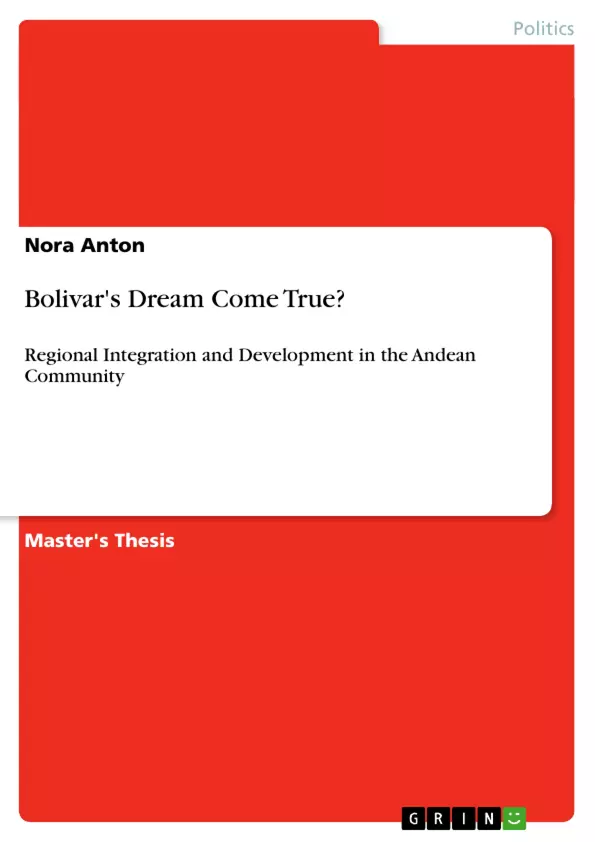Shortly after the treaties founding the European Coal and Steel Community (ECSC), European Atomic Energy Community (EAC) and European Community (EC) were signed, there were efforts in other regions of the world as well to follow this example, notably in Latin America, where, among other Associations, the Andean Pact (now Andean Community or Comunidad Andina de Naciones, CAN) was established.
In contrast to that on European integration, however, most political and academic discourse on the Andean Community agrees upon the fact that this integration process has, up to now, not been very “successful”, and quite often it is called a complete failure. This thesis wants to contribute to the search of possible reasons for this.In order to explain the lack of “success” of Andean integration – especially in the period since the late 1980s - this thesis focuses on an element which, in most integration theories, is considered the most important prerequisite for regional integration: interdependence, and thus a demand for integration on the part of the region’s citizens. It is argued that in principle, integration can create or at least reinforce its own demand, but that this has only happened in the Andean case to a relatively small extent and limited to few sectors of the highly unequal societies in Bolivia, Colombia, Ecuador, Peru and Venezuela.
Inhaltsverzeichnis (Table of Contents)
- Chapter 1 - Introduction
- 1.1 INTRODUCTION
- 1.2 PREVIOUS RESEARCH
- 1.3 METHODOLOGY
- Chapter 2 Concepts, Explanations and Consequences of - Regional Integration and a Theorisation of the Treaty of Cartagena
- 2.1 THEORIES OF REGIONAL INTEGRATION
- 2.1.1 Some Remarks about International Co-operation
- 2.1.2 Political Integration Theory
- 2.1.2.1 Intergovernmentalism
- 2.1.2.2 Neofunctionalism
- 2.1.3 Economic and Social Effects of Integration
- 2.1.3.1 Classical Trade Theory
- 2.1.3.2 Convergence or Divergence?
- 2.1.3.3 South-South Integration and Development
- 2.1.3.4 The Relation between Economic and Social Development
- 2.2 A THEORISATION OF THE CARTAGENA AGREEMENT
- 2.3 SUBCONCLUSION
- Chapter 3 - The Andean Community
- 3.1 THE REGION
- 3.2 HISTORY AND ACHIEVEMENTS OF ANDEAN INTEGRATION
- 3.3 THE INSTITUTIONAL STRUCTURE OF THE ANDEAN COMMUNITY
- 3.4 SUBCONCLUSION
- Chapter 4 - Integration and Economic Development in the CAN
- 4.1. CONDITIONS FOR EXPORT-ORIENTED ECONOMIC DEVELOPMENT IN THE CAN
- 4.2. THE REMAINING PROBLEMS
- 4.2.1 Economic barriers
- 4.2.2 Political Barriers
- 4.2.3 Physical Barriers
- 4.3 THE RESULTS: DEVELOPMENT OF CROSS-BORDER TRADE AND INVESTMENT IN THE CAN
- 4.3.1 Integration and Trade
- 4.3.1.1 Static Effects
- 4.3.1.2 Dynamic Effects
- 4.3.2 Integration and Investment
- 4.4 POLITICAL PARTICIPATION OF THE PRIVATE SECTOR IN THE CAN
- 4.5 SUBCONCLUSION
- Chapter 5 - Integration and Social Development.……........
- 5.1 THE SOCIO-ECONOMIC SITUATION IN THE ANDEAN STATES
- 5.2 THE SOCIAL EFFECTS OF INTEGRATION – CONVERGENCE OR DIVERGENCE?
- 5.3 NATIONAL AND SUPRANATIONAL SOCIAL AND REGIONAL POLICY
- 5.3.1 Policies in the Member States
- 5.3.2 Supranational Policies
- 5.4 CIVIL SOCIETY AND THE CAN
- 5.5 SUBCONCLUSION
Zielsetzung und Themenschwerpunkte (Objectives and Key Themes)
This Master's thesis aims to explore the potential for regional integration and development within the Andean Community. It examines whether Simón Bolívar's dream of regional unity has been realized through the Andean Community's efforts. The thesis analyzes the theoretical framework of regional integration, focusing on the specific case of the Cartagena Agreement, and explores the economic and social effects of integration in the Andean Community.
- Theories of Regional Integration and their Application to the Andean Community
- Economic Development and Integration in the Andean Community
- Social Development and Integration in the Andean Community
- The Impact of Regional Integration on Economic and Social Convergence or Divergence
- The Role of Civil Society in the Andean Integration Process
Zusammenfassung der Kapitel (Chapter Summaries)
Chapter 1 provides an introduction to the thesis, outlining its research objectives and methodology. Chapter 2 delves into the theories of regional integration, examining different perspectives on the process and exploring the potential consequences of integration, including economic and social effects. This chapter also offers a theorisation of the Cartagena Agreement, the foundational treaty of the Andean Community. Chapter 3 focuses on the Andean Community itself, offering a historical overview of its development, key achievements, and institutional structure. Chapter 4 examines the relationship between integration and economic development in the Andean Community, analyzing conditions for export-oriented growth, remaining challenges, and the impact of integration on trade and investment. Chapter 5 delves into the social dimensions of integration, exploring the socio-economic situation in the Andean states, the social effects of integration, and the role of national and supranational policies in promoting social development. This chapter also examines the involvement of civil society in the Andean integration process.
Schlüsselwörter (Keywords)
This Master's thesis focuses on regional integration, development, and the Andean Community. Key themes include the theorisation of the Cartagena Agreement, economic and social effects of integration, trade and investment, socio-economic conditions, convergence and divergence, and the role of civil society.
- Quote paper
- Nora Anton (Author), 2006, Bolivar's Dream Come True?, Munich, GRIN Verlag, https://www.grin.com/document/85361



